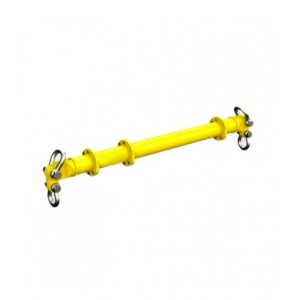
Selecting the correct equipment in heavy
material handling is very crucial for the safety of the workers, the efficiency
of the work, and the success of the project. Lifting
beams and spreader beams are often confused with one another, but they are
distinctly different pieces of lifting equipment. Being aware of these
differences helps guarantee the right equipment is chosen for the specific
requirements of the lift.
Even though lifting beams and spreader beams have somewhat similar purposes of load lifting; they do so utilising different mechanical principles.
Lifting beams function under bending stress. This kind of function includes a main beam with a singular top attachment for crane or hoist connection and multiple lower load attachment points. Each beam has a singular point on each end to create slings with a common lifting point. In lifting beams, the beam supports compression externally and tension internally from both sides.
In contrast, spreader beams work mostly
under compression. Attachment points are provided at both ends of the beam,
from where slings extend upward to a common attachment point. The arrangement
gives rise to a triangular lifting configuration whereby the beam itself is
more likely to be subjected to compression rather than bending.
The different stress patterns create notable structural differences between these beam types:
- Typical lifting beams are usually of greater construction because they need to withstand bending forces. This usually means that for heavier loads, the steel usage increases as the design becomes bulkier and heavier, because of increased bending function.
-
The design of spreader beams
allows them to be lighter and significantly more economical. Since the design
is based on compression, the material used for equivalent load capacities is
minimised. This more efficient structural engineering design is particularly
useful for longer beams which would otherwise require extremely heavy designs,
due to high bending function perpendicular to the load.
One of the most practical differences between these beam types relates to headroom requirements:
With lifting beams, the headroom needed is minimal which is advantageous for issues with height. The single lift point which is located above the beam enables operation in tight areas with vertical clearance restrictions.
Because of the triangular sling
arrangement, spreader beams need more headroom. The triangle's apex must be
positioned well above the beam itself hence these slings need greater vertical
clearance between the load and the lift.
In terms of load interactions and influence on sling angles, the beams also differ as follows:
Lifting beams simplify securing heavy loads. Their fixed attachment points guarantee that the load’s centre of gravity does not change relative to the rigging’s anchor points. This is beneficial for asymmetrical and unbalanced loads where precise positioning needs to be maintained.
Spreader beams permit more balanced load
distribution over slings, which decreases the load’s lateral forces on the load
itself and lifting tackle. This is more critical when lifting fragile or
sensitive structures that require low compressive forces.
Lifting beams excel in:
· Low-headroom facilities
· Permanent lifting points
· Static load control applications
·
Manoeuvring precision-sensitive
asymmetrically distributed mass.
Spreader beams perform best for:
· Long payloads that are supported at distant points
· Lightweight and cost-efficient lifting devices
· Low threshold for compressive forces on the payload
·
Headroom space needs are not
restricted.
Choosing between lifting and spreader beams is a matter of assessing the specific needs of the lift, the nature of the load, the environment, and the safety and health risks involved. Equipment selection is best done with the aid of lifting equipment professionals to guarantee the safety of the workplace and optimise the productivity of business operations.
Unique and more sophisticated custom
solutions which integrate elements of both beam types may be necessary to
address specific project needs. Special professional guidance must always be
obtained from competent lifting tools and equipment experts in the given field
for more complex lifts.